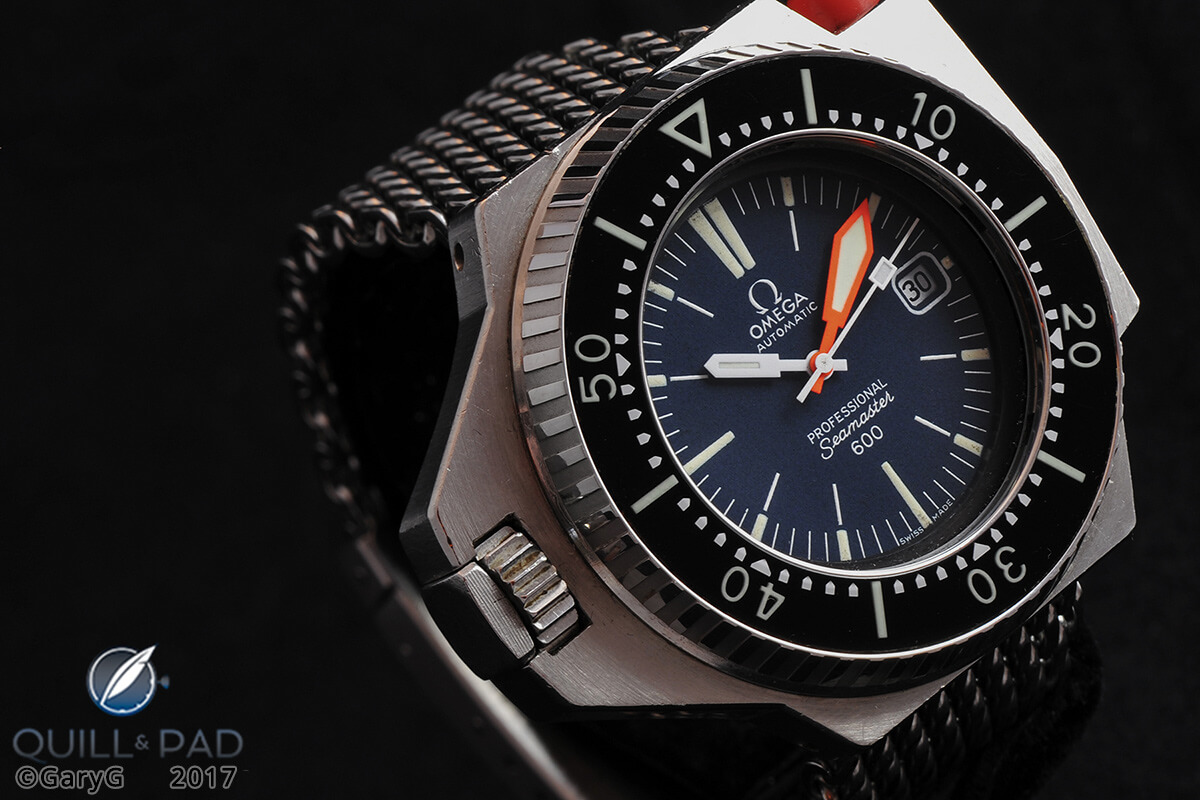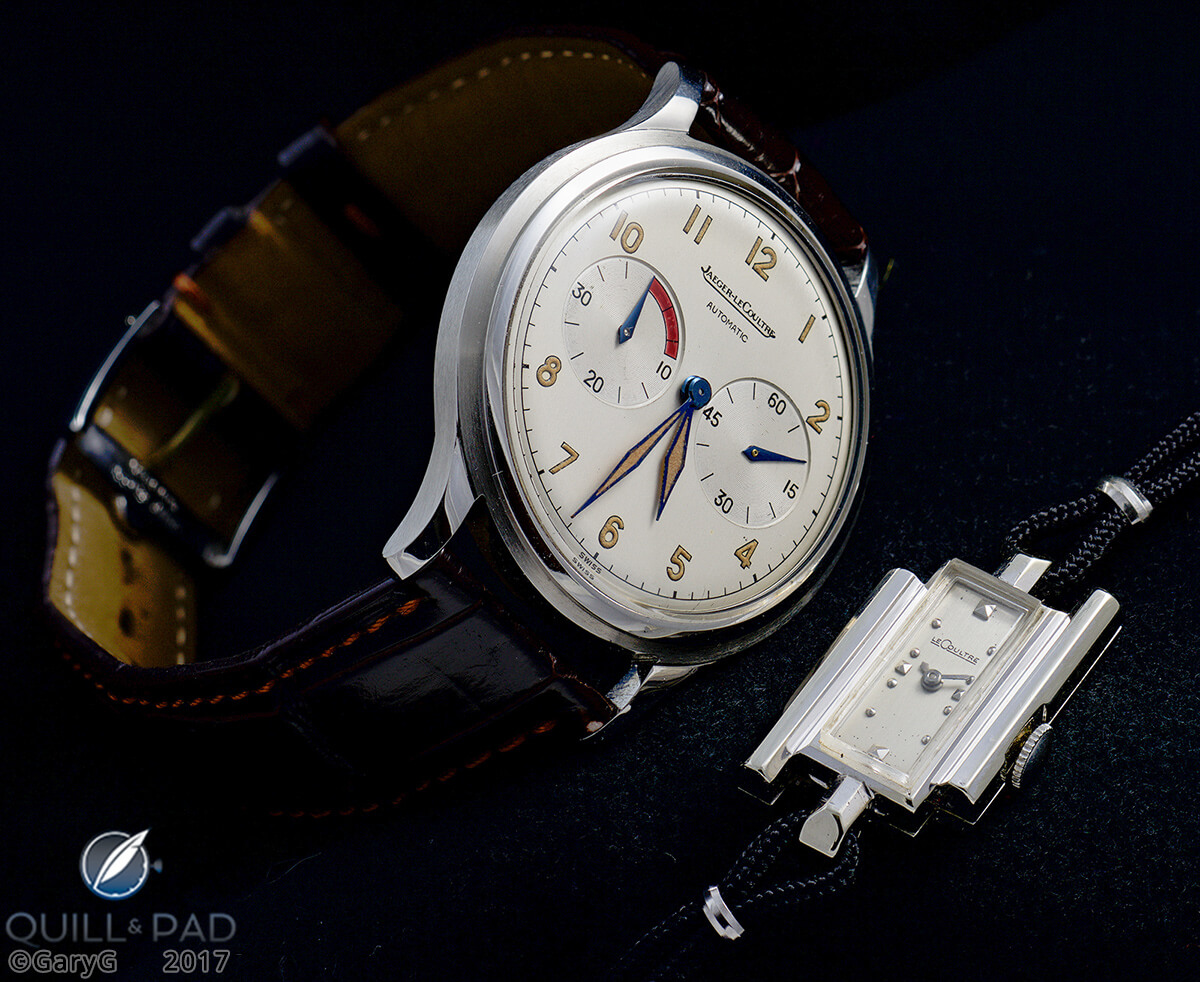A Contemporary Watch Collector Goes Vintage With Omega, Patek Philippe And Jaeger-LeCoultre – Reprise
by GaryG
To my longtime friends in the watch hobby, and perhaps to regular readers here as well, the mention of my name may conjure up a number of connotations: patron of the independents, fan of A. Lange & Söhne, admirer of Patek Philippe grand complications, and longtime customer of Jaeger-LeCoultre, among other characterizations more or less favorable.
But these likely never included vintage maven!

Vintage catch: Omega Seamaster Professional 600 Ploprof
While I own a number of older watches – some quite old, indeed – the great majority of those were passed down by my ancestors (see My Grandfather, The Watch Collector) rather than purchased by me.
Over the years, however, I have bought a few vintage pieces, and as I’ve had the opportunity to see and handle a number of top-notch older watches at the Geneva auctions (see Year-End Auctions 2016: I Came, I Saw, I Learned, I Bought and You Are There: Attending The Only Watch Auction 2015 With Patek Philippe) my appreciation for, and interest in, the vintage scene has increased substantially.
At least for the time being, the culmination of that interest was the purchase of a lovely Patek Philippe Reference 1526 at the November 2016 Phillips auction. But before we talk about that, let’s turn back the clock and check out my other vintage purchases and see what I’ve learned so far.
Omega Seamaster Ploprof 600m
While I’ve been a fan of Omega ever since boyhood evenings in front of the television watching Olympic broadcasts, and have owned a few of the brand’s watches over the years, the one I’ve bought and held is the Seamaster Ploprof.

Real wrist presence: Omega Seamaster Ploprof
For me, to see it was to love it!
In 2004, I was emerging from a quiet period of several years in my watch passion with a few focused purchases and once I saw photos of the Ploprof, which derives from the French term PLOngeur PROFessionnel (“professional diver”), I knew that I had to have one.
A few searches and conversations later, I had found a very nice-looking, freshly serviced piece with some correct updates to the hands and bezel as well as all of the original parts in small packets. The deal was done.
Back then, I knew even less about vintage watches than I do now; and I was very happy to have a watch combining a very clean original dial with factory-fresh replacement hands; obsessing about absolute correctness and its effect on future value was not even on my radar.
And, it’s a great watch!
The Ploprof is wide from side to side but not from bottom to top, and the bracelet curves directly down from the edges of the case, making it wear quite comfortably.
There are cool features like the bracelet extender allowing the watch to be worn over a dive suit and the trademark orange button keeping the bezel from turning inadvertently during a dive. And it provides some style options as well with link, mesh, and Isofrane bracelets.

Mix of original and correct replacement components: Omega Seamaster Ploprof
Coinciding with my general experience with Omegas, it keeps excellent time and it’s a robust watch, too. A quick-set date would be the only improvement I’d want, but then again there’s a certain period-correct pleasure in running the hands back and forth from 10:00 pm to 1:00 am to advance the date.
There may never be a “Ploprof Tuesday” (for an explanation of that reference, see Social Media Phenomenon Inspires New Omega Speedmaster), but at least so far for me this particular Seamaster scratches an itch that the various Speedmasters do not.
Jaeger-LeCoultre Futurematic and LeCoultre Ladies’ watch
As a long-time JLC enthusiast, I had been aware of the Futurematic but only saw one in the metal for the first time about seven years ago on the wrist of a good friend who owns a splendid collection of vintage pieces, including many unusual ones.
While, like many others, I’d considered the original Geophysic and Polaris at the pinnacle of potential Jaeger-LeCoultre vintage purchases, my encounter with the Futurematic changed my perspective.

Jaeger-LeCoultre Futurematic Jumbo in stainless steel
Like the Ploprof, it has its quirks: the Futurematic has no visible crown and in fact cannot be wound by hand at all.
There is a disk on the back of the case that is used to set the time, but that doesn’t connect to any kind of winding mechanism; and because the shaft of that disk penetrates through the movement, the automatic winding mechanism used by the movement is a “bumper” weight, bouncing from side to side with a satisfying thump.
The cleverness doesn’t stop there, though: when the watch is fully wound (as confirmed by the power reserve indicator on the dial) the thumping stops as the bumper is securely held in place until the watch is partially unwound again.
I had been on the prowl for a Futurematic for a few years when I stumbled across a wonderful stainless steel Jumbo version at Paris vintage dealer Antoine de Macedo’s shop a couple of years ago.
As you can see in the photos, Antoine had done a great job of cleaning up the watch while leaving the patina on the numerals and hands intact. The edges of the case and lugs are beautifully sharp.

Clean and crisp: the author’s vintage Jaeger-LeCoultre Futurematic
I also appreciated the way that the 37 mm case looked on my wrist. While I admired the balanced look of the dial it wasn’t until later that I learned that this particular combination of hands and Arabic numerals is not only unusual, but correct for the watch.
The price on offer was a bit above what I’d expected, but given the condition and appearance of the piece and its place in Jaeger-LeCoultre lore it wasn’t long before I was strolling the streets of Paris with it on my wrist.

MrsGaryG gets in on the vintage act: LeCoultre ladies’ watch in white gold
MrsGaryG wasn’t left out of the vintage JLC fun, either: while skimming eBay one evening I saw a charming white gold LeCoultre ladies’ piece at a very reasonable price. And before you could say “Buy It Now,” it was on its way to us.

His and hers: vintage LeCoultre watches
Patek Philippe Reference 1526 pink gold
If the Omega and Jaeger-LeCoultre pieces could be considered fun ways to dip my toe into the vintage pool, I truly dove into the deep end late in 2016 with my purchase of an example of the first-ever serially produced perpetual calendar wristwatch, the Patek Philippe Reference 1526.

Ticking legend: the first serially produced perpetual calendar wristwatch, Patek Philippe Reference 1526
I’m generally pretty thoughtful (translation: obsessive) about my deliberations on buying a watch, but this was as close to an impulse buy, especially at this price point, as it gets for me.
I really didn’t have any clear understanding of the Patek Philippe perpetual calendars prior to 1962’s Reference 3448 until I saw this classic beauty in the case at the Phillips preview.
I tried it on once, then again, then yet again as I fell hopelessly in love; and then began a cram course to learn more about early Patek Philippe perpetual calendars and the 1526 in particular from my friends both at Phillips and at the Geneva Patek Philippe Salon.

True hand-craftsmanship: dial detail, Patek Philippe Reference 1526 showing date, seconds, and moon phase
In particular, I was curious as to why a Reference 1526 in excellent condition, and a rare pink gold example at that, was valued at a fraction of the cost of the References 2497 and 2438/1 that superseded it in the line of Patek Philippe perpetual calendars.
The explanation was simpler than I thought: the 34 mm case size is currently out of fashion.

Little big watch: the author’s rare pink gold Patek Philippe Reference 1526
On my wrist, however, the combination of long lugs and small bezel make the watch wear bigger than its actual size, and when everyone began using terms like “undervalued” and “most under-appreciated Patek Philippe perpetual calendar,” my mind was made up.
Events at the auction went my way, and now I suppose I am closer to being a “vintage guy!”

Vintage appeal: champlevé dial and hand-formed hands of the Patek Philippe Reference 1526 in pink gold
Enjoying the vintage scene
For me, the joy of testing the vintage waters is that, in many ways, it’s like starting the learning journey of watch collecting all over again.
While I’m building a rudimentary appreciation for the “rules” of not getting hurt with vintage (condition, correctness, and rarity come to mind), I’m still at a point at which I’m truly buying what I love rather than being influenced too much by others’ views of what I should be fancying.

Parting shot: crown and case detail, Patek Philippe Reference 1526 in pink gold
I can imagine that as the years pass, I may adjust and ultimately refocus my portfolio to focus on fewer big-ticket contemporary pieces and a larger number of affordable, wearable vintage pieces.
For now, though, I have the luxury of trying both, and I’m having a blast.
Quick Facts Omega Seamaster Professional 600 Ploprof Ref. 166.0077
Case: monobloc stainless steel, 45 x 54 x 15 mm, with anti-reflective mineral crystal; bi-directional rotating locking stainless steel bezel; water-resistant to 600 meters; square crown with knurled locking ring
Dial: painted metal dial with luminous tritium markers; “Plongeur” hands with luminous highlights (original hands tritium, Omega service hands Super-LumiNova); black-on-silver date display at 3 o’clock
Movement: automatic Omega 1002
Functions: hours, minutes, seconds; date
Years of production: 1970-1979
Recent sale prices: $6,000 to $8,000, depending on condition; Ploprof prototype sold for CHF 87,500 at Sotheby’s in November 2016
Quick Facts Jaeger-LeCoultre Futurematic Jumbo
Case: stainless steel, 37 x 10.7 mm; setting crown on rear of case, acrylic crystal
Dial: silver dial with painted and luminous markers; blued hands with luminous hour and minute hands
Movement: automatic JLC Caliber 497 “bumper” movement with hacking seconds; governor on winding mechanism when fully wound, 40-hour power reserve
Functions: hours, minutes, small seconds; power reserve indication
Years of production: 1953-1962
Recent sale prices: $2,500 to $8,500, depending on condition
Quick Facts LeCoultre Ladies’ Watch
Case: 14-karat white gold, 15 x 24 mm
Dial: silver dial with silver-tone hour and minute hands; applied square and round hour markers
Movement: manual winding LeCoultre Cal. 490/BW, 17 jewels; marked VXN to denote Vacheron Constantin factory provenance
Estimated production date: 1950s
Estimated value: $400 to $800
Quick Facts Patek Philippe Reference 1526 Pink Gold
Case: pink gold, 34 mm
Dial: gold dial with champlevé enamel numerals and minute tracks; applied pink gold dots and Arabic numerals; gold moon disk with hand-applied fired blue enamel background; hammered gold hands with blued hand for date
Functions: hours, minutes, small seconds; date, moon phase, day, month
Movement: manually wound Caliber 12”120 Q, Victorin Piguet base movement
Production number: 210 total examples of Reference 1526 including all metals, with a small minority in pink gold
Production years: 1941-1952
Recent auction price: 150,000 Swiss francs
* This article was first published on March 17, 2017 at A Contemporary Watch Collector Goes Vintage.
You may also enjoy:
Are Today’s Vintage Watch Buyers Killing Watchmaking?
Why I Bought It: Vintage Mathey-Tissot Type 20 Big Eye Chronograph
Leave a Reply
Want to join the discussion?Feel free to contribute!



A Ploprof owned by a crew member of Jacque Cousteau’s Calypso sold at the Antiquorum Geneva auction last Fall for >100,000 CHF
Wow! I don’t think mine has anything like that provenance but the market for pre-owned and vintage watches is doing some pretty wild things these days…
Best, Gary